TL;DR
- Cross-training enhances ballet performance by building complementary strength and flexibility.
- Focus on core stability, upper body strength, and lower body conditioning.
- Incorporate flexibility work and low-impact cardio to maintain endurance.
- Always prioritize proper form and consult professionals to avoid injury.
- Balance cross-training with ballet practice for optimal results.
Ballet demands exceptional strength, flexibility, and endurance, but relying solely on barre and center work can lead to imbalances and increased injury risk. Cross-training—incorporating exercises from other disciplines—provides the perfect complement to ballet training. By targeting areas that ballet may overlook, such as overall muscle balance and cardiovascular fitness, cross-training helps dancers build a stronger, more resilient body. This guide explores effective cross-training exercises tailored for ballet dancers, ensuring you enhance your performance while staying safe.
Why Cross-Training Matters for Ballet Dancers
Ballet is highly specific, emphasizing turnout, extension, and precise movements. However, this focus can create weaknesses in other areas, like overall stability or opposing muscle groups. Cross-training addresses these gaps.
- Injury Prevention: Strengthens supporting muscles to reduce strain on joints and ligaments.
- Improved Performance: Builds power and endurance for jumps, turns, and sustained holds.
- Muscle Balance: Counteracts the imbalances caused by repetitive ballet movements.
- Mental Refreshment: Provides variety, preventing burnout and keeping training engaging.
Incorporate cross-training 2-3 times per week, ideally on non-ballet days, to allow recovery.
Core Stability Exercises
A strong core is the foundation of ballet, supporting posture, balance, and power. These exercises target the deep abdominal muscles and back stabilizers.
- Planks: Hold a forearm plank for 20-30 seconds, focusing on keeping your body in a straight line. Progress by lifting one leg or arm.
- Bird-Dog: On all fours, extend opposite arm and leg while maintaining a neutral spine. Hold for 5-10 seconds per side; repeat 10 times.
- Russian Twists: Sit with knees bent, lean back slightly, and rotate your torso side to side. Use a medicine ball for added resistance.
Perform these 2-3 sets of 10-15 reps, emphasizing controlled movements to engage the core without straining the back.
Upper Body Strength Training
Ballet often neglects upper body development, but strong arms and shoulders improve posture and support for lifts or extensions.
- Push-Ups: Start with knee or wall variations. Focus on full range of motion to build chest, shoulders, and triceps.
- Rows: Use dumbbells or resistance bands to pull elbows back, squeezing shoulder blades. This strengthens the back and improves posture.
- Shoulder Press: Press weights overhead from shoulder height, engaging the deltoids and upper back.
Aim for 3 sets of 8-12 reps. Keep weights light to maintain ballet’s emphasis on control over bulk.
Lower Body Conditioning
While ballet builds leg strength, cross-training adds variety and targets different muscle fibers for better power and stability.
- Squats: Stand with feet shoulder-width, lower as if sitting back into a chair. This builds quads, glutes, and hamstrings without the turnout focus of ballet pliés.
- Lunges: Step forward into a lunge, keeping the front knee over the ankle. Alternate legs for balance and unilateral strength.
- Calf Raises: Rise onto toes and lower slowly. Perform on one leg for added challenge, mimicking relevé but with added resistance.
Incorporate 3 sets of 10-15 reps, using body weight or light weights to avoid overloading ballet-stressed muscles.
Flexibility and Mobility Work
Ballet requires exceptional flexibility, but cross-training can enhance it through dynamic movements and targeted stretching.
- Dynamic Leg Swings: Swing one leg forward and back like a pendulum, increasing range gradually. This improves hip mobility for higher extensions.
- Yoga Poses: Incorporate downward dog, warrior poses, or pigeon for deep stretches in hips and hamstrings.
- Foam Rolling: Roll tight areas like IT band or calves to release tension and improve recovery.
Spend 10-15 minutes post-workout on these, holding stretches for 20-30 seconds without bouncing.
Cardiovascular Conditioning
Ballet builds some cardio through class intensity, but dedicated cardio enhances endurance for longer rehearsals or performances.
- Swimming: Low-impact full-body workout that builds stamina without stressing joints.
- Cycling: Stationary or outdoor cycling improves leg endurance and cardiovascular health.
- Brisk Walking or Jogging: Keep it light to maintain recovery; focus on steady pace rather than high intensity.
Aim for 20-30 minutes, 2-3 times per week, at a moderate intensity to support rather than compete with ballet training.
Safety Tips for Cross-Training
To maximize benefits and minimize risks, follow these guidelines:
- Consult Professionals: Work with a trainer or physical therapist familiar with dancers to tailor exercises.
- Warm Up Properly: Always start with 5-10 minutes of light cardio and dynamic stretches.
- Listen to Your Body: Stop if you feel pain (beyond normal muscle fatigue) and modify exercises as needed.
- Progress Gradually: Increase intensity or weight slowly to allow adaptation.
- Balance with Rest: Ensure adequate recovery days to prevent overtraining.
Conclusion
Cross-training is a powerful tool for ballet dancers, offering a well-rounded approach to fitness that enhances performance, prevents injuries, and promotes longevity in the art form. By integrating these exercises thoughtfully, you’ll develop a stronger, more balanced body that supports your ballet goals. Remember, consistency and proper form are key—start small, track your progress, and enjoy the journey toward becoming a more versatile and resilient dancer. Happy training!

